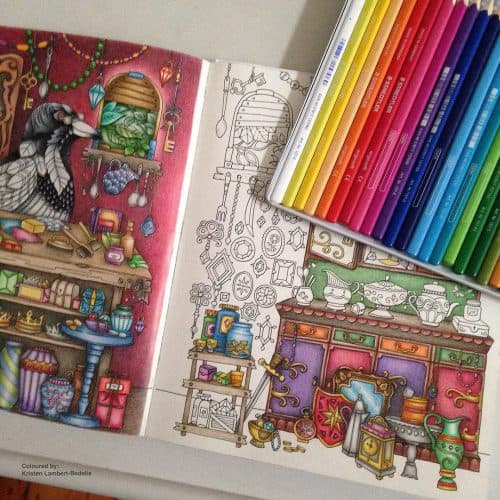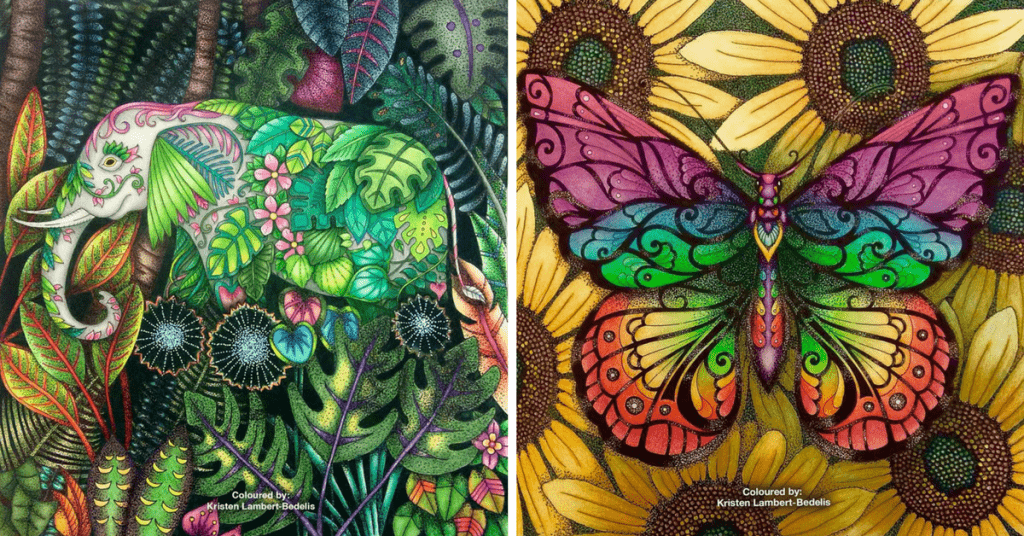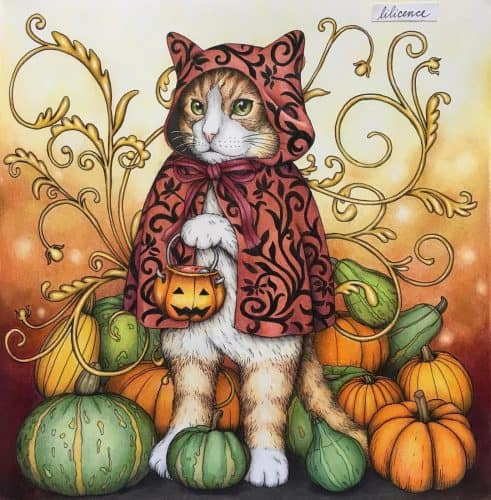
Are you an enthusiastic colorist ready to experiment and take your art to the next level? Would you like to learn the best adult coloring tips and techniques used by other talented colorists? Then you’ll absolutely love this insightful article revealing lots of secrets and tricks that you should definitely try with your next coloring page.
We found and interviewed real pros who shared their experience and gave practical advice to help you upgrade your coloring skills. In our previous POST, we featured a fantastic interview with Irena Herman. And today we put together one more article with the help of brilliant colorists Luca Guidi, Kristen Lambert-Bedelis and Lilicence H. We hope you find it fun and helpful!
Choosing Designs and Colors

Choosing what to color is obviously the first step, which can be the most overwhelming. There’s a huge variety of different coloring pages out there which makes it hard figuring out where to start. Luca Guidi suggested that the easiest designs are the natural ones: for examples, flowers. He started with Secret Garden by Johanna Basford, a lot of flowers, leaves and small animals. Both Kristen and Lilicence think that mandalas and abstract shapes would be perfect for beginners, because “they’re not meant to be realistic and so there is no pressure to make them look like anything, just add any color anywhere and relax.“
When it comes to choosing colors, some people always plan ahead while others decide as they go along. Lilicence mentioned that sometimes she gets a craving to use a certain color: “like yellow-orange, and then I’ll look through my coloring books for a page that’ll suit that color“. She kindly shared website link where you can pick color palettes: http://colorpalettes.
Summing it up: start with something simple, that doesn’t have to look realistic and will allow you to rely on our imagination, like mandalas or abstract shapes. If you are not sure what colors to use, just google and check out some of the ready color palettes on the internet.
Choosing the Right Tools

Choosing the right tools is essential, however, the term “right” in adult coloring simply means whatever feels right for YOU. Most colorists that we talked to prefer colored pencils because of their versatility. Lilicence always uses different brands, depending on the paper. Her most used pencils are Polychromos. She also recommends Zig Watercolor brush pens and alcohol markers. “Sometimes a base layer of a marker can really speed up the process and help tint the paper tooth so you don’t see the white specks where the pencil didn’t get to.”
Kristen prefers Faber Castell Polychromos, Staedtler Triplus fine liners and Prismacolor black pencil (for added depth).
Summing it up: we recommend starting with colored pencils. Try different brands to see which ones work best with your favorite paper. Use watercolors or markers to speed up the work and prevent white specks from where your pencils didn’t get to.
Getting Ready and Inspired

Inspiration is the key when it comes to creativity. Finding your source of inspiration is important. Once again there’s no right or wrong. Luca suggests to always look around and take inspiration from everything like nature, photos, music, people, books and other people’s artworks. Lilicence is often inspired by colors and an environment she is in: “when it’s spring instead of winter, what I’ll be drawn to is different“. Kristen is motivated by other colorists and their accomplishments on Instagram and Facebook.
Summing it up: there’s no such thing as a wrong source of inspiration. It can be literately anything. Whether it’s a song, a poster or a TV show that excites you and gets into the coloring mood, use this drive to create beautiful artworks.
More Practical Tips for Beginners

Here are some tips to help you dive deeper into the process of coloring. Luca recommends to try different medium and techniques, be original and go out of your comfort zone from time to time. He also believes that it’s important to share with others and ask for their opinion. Lilicence mentioned that it’s very helpful to look up references of what you want to color by simply using google image search. She spends a lot of time working on shadows and blending the colors but references make it much easier for her. Kristen thinks it’s necessary to invest in good quality pencils that produce more vibrant colors than budget ones and also start with coloring basic patterns before trying more detailed pictures. That will help you build up your confidence.
Summing it up: choose the coloring books and pages that resonate with you and really capture your imagination. If possible, get lots of different high-quality coloring tools. Use image references to decide on colors and styles.
Creating Realistic Artworks

Some colorists prefer abstract patterns while others really strive for realism. If you would like to learn some great tips on creating realistic artworks, this section is for you!
For those who color with pencils, Kristen recommends applying a light touch and color in small circles (so you can’t see lines) starting in light shades of a color building up to darker shades. Luca confirmed that he gets volume using the contrast between lights and shades. Lilicence states that the secret is in shadows: “not just a hard shadow around every edge, though that is a cool illustrative effect, soft gradients of shadows to denote where there is less light due to the shape.”
Summing it up: try experimenting with shadows and work on the contrast between light and dark shades.
Working on Hair and Skin Tones

Hair and skin are usually the hardest parts of a coloring page. But it doesn’t mean that you have to give up on them. With these cool tips from our experts, you’ll easily master the art of coloring hair and skin.
Follow Lilicence advice and start by looking up reference images on the web. Using references will really help you better understand shadows and highlights. Also don’t forget to color more gently when moving on to a face, comparing to the other parts of your design. Lilicence agrees that hair is really challenging. She normally starts by working with strokes from light to dark. Remember to alternate light and heavy pressure to accentuate shadows. Build up layers with rhythmic strokes.
You can also try and add the dark and light colors first, after that fill in the gap with mid-tones. Don’t be afraid to use lots of pencils of different shades for just your skin or hair.
Summing it up: find and study references, apply strokes from light to dark and use as many shades of the same color as possible in between to achieve realistic results.
Background Tips

If you are scared of doing backgrounds or simply prefer to leave that space white, that’s ok. But if you are ready to experiment and make your artworks really stand out, then you are going to love these cool tips.
For some colorists, a background is really the main part of the artwork. Coloring backgrounds is really creative and intimidating at the same time. Most people are simply afraid of messing up their work. Try to start with a background for a change. The easiest way is to make it blurry. Lilicence really enjoys blending and layering colors into each other. Kristen recommends trying watercolor pencil for backgrounds because they are much quicker than just regular pencils.
You should definitely check up the references for inspiration. With time you’ll be able to experiment more and even add your own elements to the background like butterflies, flowers or gel pen dots. If you feel like you accidentally ruined your work, simply color the ruined parts with black acrylic paint.
Summing it up: check up references, keep it simple at the beginning and start with blurry backgrounds, try watercolor pencils to speed up the work.
Best Techniques You Need to Try

Expert colorists are familiar with lots of different techniques that help them take their art to the next level. Are you ready to learn these techniques too?
Blending, shading, and layering are the basics. Lilicence uses harder pencils for layering and blends the edges with softer ones. Sometimes she adds a tiny bit of a pale watercolor of the same shade on top and smudges it in with her finger. You can also use a black color on the edges for more contrast. When it comes to large parts or backgrounds, don’t be afraid to use watercolors and apply them with different brushes. Experiment and see which one gives you the desired effect. Using a sponge is a very creative and smart idea to try. Kristen revealed that she likes the pointillism technique when she uses a black fine liner to gradually layer black dots to give depth.
Summing it up: start with the basic techniques like blending, sharing and layering. Once you mastered them, experiment with watercolors and different brushes.
Let Us Know What You Think
Do you find these tips useful? Leave your COMMENTS and FEEDBACK below!
LIKE & SHARE ![]()
![]()
![]() this FACEBOOK POST with your friends! And don’t forget to apply these tips to your next artworks.
this FACEBOOK POST with your friends! And don’t forget to apply these tips to your next artworks.




